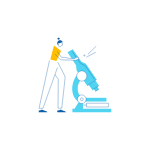If your child is having difficulty in school, you aren’t alone. It is estimated that 1 in 5 children in the U.S. have some form of learning or attention disorder. Learning disorders can include issues, such as ADD/ADHD, Autism Spectrum Disorder (ASD), emotional disturbances, behavioral problems, and traumatic brain injury (TBI). Children with learning issues may be just as smart as their classmates, but they have trouble living up to their academic potential. Nearly half of all parents mistakenly believe that their children will outgrow these difficulties, which means these children don’t get the help they need to succeed. This can lay the foundation for a lifetime of feelings of inadequacy, shame, frustration, and low self-esteem.
Learning disabilities are neurologically based processing issues that can affect people of all ages. Most often they are detected in childhood as issues with learning skills such as reading and writing, science or math. However, they can also affect adults with higher-level skills, such as time management and organization, and they can cause issues with short-term memory and the ability to focus and pay attention.
People who struggle with learning disabilities have varied issues that can range from mild to severe. Children may show signs of reading and writing problems or have an inability to focus or pay attention. In other cases, they may not see letters in the same order as others, words on a page may look out of place, or when writing, words don’t fall in the correct order. They may act out regularly or have trouble making friends. Adults also could have issues with reading and writing, and many report that spelling is difficult for them. In addition, many children and adults experience impaired short-term memory issues.
There are many factors that can contribute to having a learning disability such as:
Our Mission
Through our brain imaging work using SPECT technology, we have discovered that learning issues—such as attentional, emotional, or behavioral problems—are not single or simple disorders. They all have multiple types, including 7 types of ADD/ADHD and 7 types of anxiety and depression. That’s why giving everyone the same treatment will never work. Treatment that is beneficial for one child (or adult) may not work for another or could even make their symptoms worse. This is why we create a personalized treatment plan for each person based on their brain type. We have also found that lifestyle interventions and other natural strategies can help improve symptoms in children and adults with certain learning disorders and other problems, which is why we take a comprehensive approach to healing.

Our brain imaging work shows that people with learning disabilities have abnormal function in areas of the brain involved in cognitive processes necessary for learning, including language, writing, reading, problem-solving, attention, memory, math, and information processing.
SPECT (single photon emission computed tomography) is a nuclear medicine study that evaluates blood flow and activity in the brain. Basically, it shows three things: healthy activity, too little activity, or too much activity. The healthy surface brain SPECT scan on the left shows full, even symmetrical activity. In the scan on the right, which is from a child with ADD/ADHD who was having trouble in school, you can see areas of low activity that look like holes in the prefrontal cortex. This brain region is involved in attention, focus, and problem-solving and when activity is low, children (and adults) can have problems in these areas.
Children with emotional problems may have anxiety, depression, or other mental health issues. An estimated 4.4 million children aged 3-17 have anxiety and approximately 1.9 million have depression, according to the CDC. About 30% of children and adolescents will be affected by anxiety, but 80% of them don’t get the help they need. These conditions can lead to a number of problems in school, such as test anxiety, trouble speaking in front of peers, lack of motivation, or irritability.
Almost all kids and adolescents can occasionally act defiantly with their teachers, get aggressive with classmates, or have a temper tantrum in class. When this type of conduct becomes a long-lasting pattern with negative consequences, it’s considered a behavioral problem.
Children who have trouble reading, learning difficulties, anxiety, low motivation, ADD/ADHD, headaches, autism, or TBI may have a condition called Irlen Syndrome. This is a visual processing problem, where certain colors of the light spectrum tend to irritate the brain. Irlen Syndrome affects 12-14% of the general population; but it afflicts 33% of people with ADHD or autism; nearly 50% of individuals with reading or learning challenges; and 55% with head injury, concussion, or whiplash. Students who take a long time to complete homework, do poorly on exams, or avoid reading assignments should be screened for this condition.
This is some of the feedback we have received from our esteemed clients.
























Literally everyone. I’m currently helping people from 12 to 60+ years old. Everyone is getting an adjusted program and a meal plan.
© Nipro Life Sciences Private Limited. All Rights Reserved.
